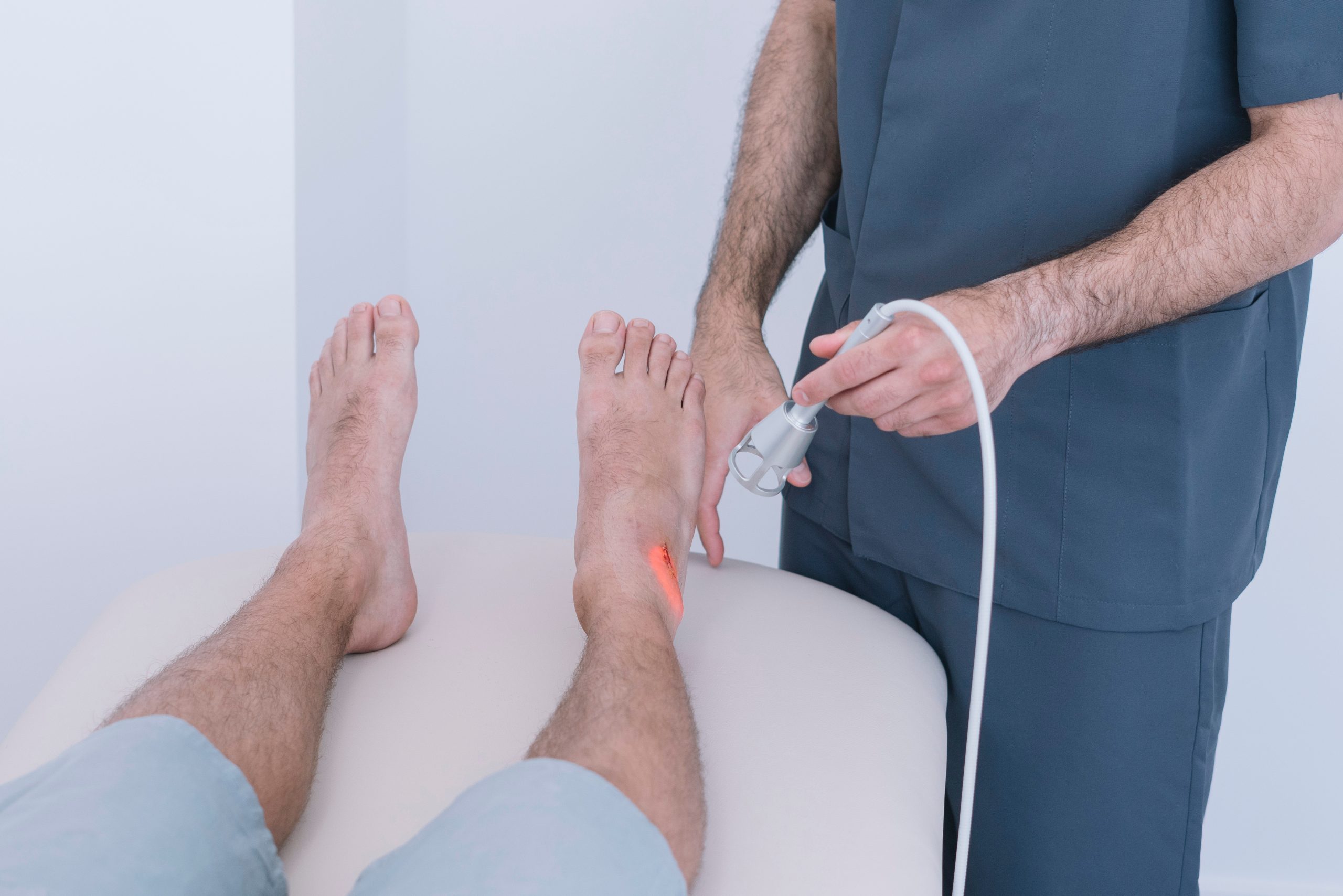
Laser treatment for feet, like ultrasound treatments, is a lesser-known podiatric solution among the public. However, it’s an interesting alternative to invasive treatments. Quick to perform and yielding long-lasting results, foot laser treatments may interest you if you suffer from acute or chronic foot pain.
How does a laser treatment work (and are laser treatments safe)?
Many patients approach laser therapy with a slew of questions: What is laser treatment? How does laser therapy work? And, most importantly, are laser treatments safe? The first thing to know is that these types of lasers differ drastically from industrial lasers—so there’s no need to worry about pain or injury. The entire process is extremely safe.
So, what exactly is laser treatment? Simply put, laser treatment for the feet involves applying light beams to the afflicted area of the body. The light emitted is powerful enough to penetrate superficial layers of the skin to reach the affected tissue that needs treatment.
Safe and precise, the treatment employs a low-intensity frequency absorbed by the body tissue. It’s a phenomenon called photobiomodulation, in which light is transformed into energy as it comes into contact with the targeted cells.
Foot laser therapy is safe and poses no burning risks. The only precaution is to protect your eyes, as they can be vulnerable to radiation emitted by the device. Therefore, you and the chiropodist are equipped with protective glasses during the procedure.
When are foot laser treatments needed?
Soft tissue and certain bone structures respond well to foot laser treatments. The procedure activates and accelerates the body’s healing process. Moreover, the slight heat generated in the tissue soothes and relaxes the targeted area. Laser therapy may be a good option for relief if you’re experiencing inflammatory pain or if the ailment results from an injury. Inflammatory conditions eligible for foot laser treatments include Achilles tendonitis, plantar fasciitis, and metatarsalgia.
Diseases affecting the ankle and foot bones—as well as pain related to osteoarthritis and rheumatoid arthritis—can also benefit from laser treatments. Finally, foot laser treatments can eliminate post-operative pain or pain resulting from sports injuries (such as stress fractures or muscle strains). It’s also possible your chiropodist will recommend this solution (either as a standalone treatment or as part of a larger plan) to remedy neuropathic pain, especially Morton’s neuroma.
Advantages of feet laser treatments
From a practical viewpoint, laser therapy for the feet has many advantages—notably, the painlessness of the procedure and the swiftness of recovery. How does a laser treatment work for healing? It’s a therapy that stimulates the body’s healing process. The vasodilator effect (dilation of the blood vessels) improves blood circulation and oxygenation in the cells, which activates regeneration. Inflammation of the damaged tissue is reduced, which leads to relief the moment the laser’s applied. If the condition is treated in time, laser treatments for the feet can even replace surgery, significantly reducing remission times. And because it can relieve some symptoms without necessarily treating them, foot laser treatments are sometimes performed in combination with other treatments prescribed by a chiropodist.
Feet laser treatment contradictions
While laser therapy has no side effects, ensuring it’s suitable for your condition is essential. A podiatric assessment carries out all necessary biomechanical evaluations. And to mitigate risks, your chiropodist often accompanies the examination with a preliminary ultrasound or X-ray.
It’s crucial always to inform your healthcare professional of medical conditions or other factors affecting the skin. Let your chiropodist know if you have a tumour or tattoo in the area to be treated. In the latter case, the laser can damage the tattoo by dissolving the ink under the skin.
What exactly happens during foot laser treatments?
The healthcare professional determines the laser frequency based on your condition and whether it affects the joints or soft tissue. At the start of the treatment, you’ll be asked to sit or lie comfortably while the chiropodist marks the targeted area. As mentioned earlier, everyone in the room must wear protective glasses to prevent the laser from coming into contact with the eyes.
Next, the treatment is applied to the skin’s surface with a transmitter. The painless process often produces a soft sensation of heat or tingling. Session times vary depending on the size of the area being treated but only last a few minutes. On average, the ailment is healed in 2 to 5 sessions. At the end of every session, you’ll be advised on how to prolong the laser’s benefits and reminded not to overwork the foot.
Alternatives to foot laser treatments
In addition to laser therapy, many ways exist to treat inflammatory and musculoskeletal foot pain. For instance, the chiropodist may begin with manual therapy, in which the foot is manipulated to restore balance. Often, this treatment is accompanied by therapeutic taping so the treated areas can rest and recover. Manual therapy can also accompany orthotics, moulded and custom-made for everyone. Orthoses relieve pressure points in the arches, soothe inflammation, and help the patient restore mobility.
Lastly, the chiropodist may prescribe medication that’s reinforced by laser therapy.
However, if none of these therapies help the patient regain their quality of life, surgery or ShockWave therapy may be considered. An evaluation is, of course, necessary to determine the best approach.
Get a biomechanical assessment at a FootNetwork member clinic
Pain in the lower kinetic chain can impede mobility rather quickly. To maintain your quality of life, our chiropodists do everything possible to treat your pain effectively. Check out the list of chiropody clinics in Ontario to find the one nearest you.

